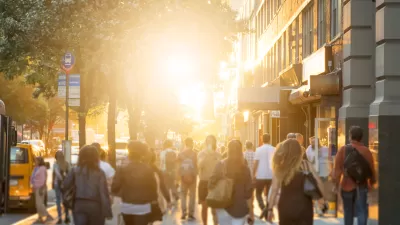A new comprehensive plan being released in Raleigh has many -- both in and out of the city -- wondering what's the best way to grow in the post-sprawl world.
"The era of suburban sprawl is ending, these planners maintain, not simply because of high gas prices, but because it is fundamentally unsustainable. As Christopher Leinberger, a fellow at the Brookings Institution in Washington, D.C., put it in a recent talk, the more "drivable suburban" neighborhoods a city allows, the lower the quality of life becomes for everyone living in them. The fastest-growing market now, said Leinberger, a developer, is for "walkable urban" places: the kind Raleigh doesn't have, yet needs to create, that are modeled on what cities were before cars took them over."
"Such places are far more complicated to build and manage than the suburbs, Leinberger said. But done right, these areas improve as they grow. They have more cultural diversity and housing options-and with public transit, the chance for people to save money by owning fewer cars, or none. If Raleigh fails to create them, Leinberger warned, 'You will be left in the 20th century.'"
"The question for Raleigh is where these walkable urban places should be."
"Leinberger's analysis and the other experts' jibes with the basic goal of the comprehensive plan to curb sprawl and guide development into designated "growth centers." Yet it also raises the issue of whether the plan identifies too many centers-including some in places that can never be urban."
"In addition to the downtown regional center, the plan shows seven other "city growth" areas. Some of the seven are tangential to a string of distinct, "transit-oriented development" zones along a planned commuter-rail line; some are along the beltline highways (Interstate 440 and Interstate 540) and nowhere near the transit corridor."
"The plan invites the redevelopment of shopping centers and strip malls along these and other major roads, such as Capital Boulevard, as mixed-used urban spaces. But to hear the planners tell it, such redevelopments are rare."
FULL STORY: Imagine Raleigh without sprawl

Alabama: Trump Terminates Settlements for Black Communities Harmed By Raw Sewage
Trump deemed the landmark civil rights agreement “illegal DEI and environmental justice policy.”

Study: Maui’s Plan to Convert Vacation Rentals to Long-Term Housing Could Cause Nearly $1 Billion Economic Loss
The plan would reduce visitor accommodation by 25% resulting in 1,900 jobs lost.

Why Should We Subsidize Public Transportation?
Many public transit agencies face financial stress due to rising costs, declining fare revenue, and declining subsidies. Transit advocates must provide a strong business case for increasing public transit funding.

Paris Bike Boom Leads to Steep Drop in Air Pollution
The French city’s air quality has improved dramatically in the past 20 years, coinciding with a growth in cycling.

Why Housing Costs More to Build in California Than in Texas
Hard costs like labor and materials combined with ‘soft’ costs such as permitting make building in the San Francisco Bay Area almost three times as costly as in Texas cities.

San Diego County Sees a Rise in Urban Coyotes
San Diego County experiences a rise in urban coyotes, as sightings become prevalent throughout its urban neighbourhoods and surrounding areas.
Urban Design for Planners 1: Software Tools
This six-course series explores essential urban design concepts using open source software and equips planners with the tools they need to participate fully in the urban design process.
Planning for Universal Design
Learn the tools for implementing Universal Design in planning regulations.
Smith Gee Studio
Alamo Area Metropolitan Planning Organization
City of Santa Clarita
Institute for Housing and Urban Development Studies (IHS)
City of Grandview
Harvard GSD Executive Education
Toledo-Lucas County Plan Commissions
Salt Lake City
NYU Wagner Graduate School of Public Service





























